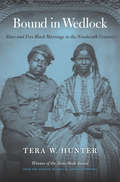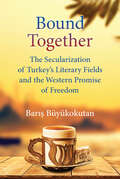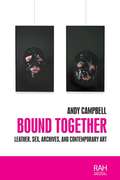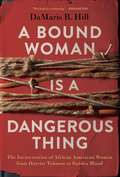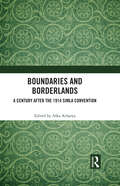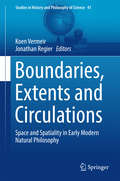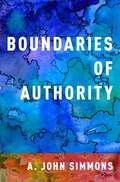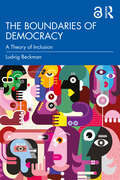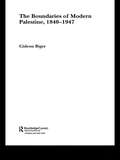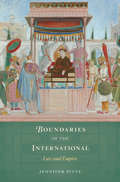- Table View
- List View
Bound in Venice: The Serene Republic and the Dawn of the Book
by Alessandro Marzo MagnoThe Serene Republic and the Dawn of the BookA highly readable but erudite book in the style of Alberto Angela’s A Day in the Life of Ancient Rome, this is the compelling story of fifteenth-century Venice, at that time the mercantile and cultural capital of the world. There, the first genuine publishing houses open for business leading to an explosion of the written word and an unprecedented diffusion of human knowledge. Among the innovators who are driving these new cultural enterprises, one remarkable visionary, Aldo Manuzio, a man credited with inventing the figure of the modern publisher, stands head and shoulders above the rest. Manuzio will publish the first printed editions of the Talmud, the Koran, the works of Erasmus of Rotterdam, and classics of Greek and Latin poetry and theater, bringing about a true revolution and the birth of the modern.
Bound in Wedlock: Slave and Free Black Marriage in the Nineteenth Century
by Tera W. HunterTera W. Hunter offers the first comprehensive history of African American marriage in the nineteenth century and into the Jim Crow era. She reveals the practical ways couples adopted, adapted, or rejected white Christian ideas of marriage, creatively setting their own standards for conjugal relationships under conditions of uncertainty and cruelty.
Bound to the Warrior (Mills And Boon Love Inspired Historical Ser.)
by Barbara PhinneyA HEART UNCONQUERED
Bound To The Wolf Prince: Claimed By The Wolf Prince Bound To The Wolf Prince The Highlander And The Wolf Princess (Legend of the Faol #2)
by Marguerite KayeScottish Highlands, 1703 As the new Alpha of the Faol, a legendary clan possessing the power of the wolf, Eoin Tolmach knows he should put the needs of his people before his own. Yet the former warrior cannot resist the challenge of rescuing kidnapped heiress Freya Ogilvie himself…or his unexpected attraction to her.
Bound Together: The Secularization of Turkey’s Literary Fields and the Western Promise of Freedom
by Baris BüyükokutanBound Together takes a new look at twentieth-century Turkey, asking what it will take for Turkish women and men to regain their lost freedoms, and what the Turkish case means for the prospects of freedom and democracy elsewhere. Contrasting the country’s field of poetry, where secularization was the joint work of pious and nonpious people, with that of the novel, this book inquires into the nature of western-nonwestern difference. Turkey’s poets were more fortunate than its novelists for two reasons. Poets were slightly better at developing the idea of the autonomy of art from politics. While piety was a marker of political identity everywhere, poets were better able than novelists to bracket political differences when assessing their peers as the country was bitterly polarized politically and as the century wore on. Second, and more important, poets of all stripes were more connected to each other than were novelists. Their greater ability to find and keep one another in coffeehouses and literary journals made it less likely for prospective cross-aisle partnerships to remain untested propositions.
Bound together: Leather, sex, archives, and contemporary art (Rethinking Art's Histories)
by Andy CampbellWhat are the archives of gay and lesbian leather histories, and how have contemporary artists mined these archives to create a queer politics of the present? This book sheds light on an area long ignored by traditional art history and LGBTQ studies, examining the legacies of the visual and material cultures of US leather communities. It discusses the work of contemporary artists such as Patrick Staff, Dean Sameshima, Monica Majoli, AK Burns and AL Steiner, and the artist collective Die Kränken, showing how archival histories and contemporary artistic projects might be applied in a broader analysis of LGBTQ culture and norms. Hanky codes, blurry photographs of Tom of Finland drawings, a pin sash weighted down with divergent histories – these become touchstones for writing leather histories.
Bound together: Leather, sex, archives, and contemporary art (Rethinking Art's Histories)
by Andy CampbellWhat are the archives of gay and lesbian leather histories, and how have contemporary artists mined these archives to create a queer politics of the present? This book sheds light on an area long ignored by traditional art history and LGBTQ studies, examining the legacies of the visual and material cultures of US leather communities. It discusses the work of contemporary artists such as Patrick Staff, Dean Sameshima, Monica Majoli, AK Burns and AL Steiner, and the artist collective Die Kränken, showing how archival histories and contemporary artistic projects might be applied in a broader analysis of LGBTQ culture and norms. Hanky codes, blurry photographs of Tom of Finland drawings, a pin sash weighted down with divergent histories – these become touchstones for writing leather histories.
A Bound Woman Is a Dangerous Thing: The Incarceration of African American Women from Harriet Tubman to Sandra Bland
by DaMaris HillA Publishers Weekly Top 10 History Title for the seasonA revelatory work in the tradition of Claudia Rankine's Citizen, DaMaris Hill's searing and powerful narrative-in-verse bears witness to American women of color burdened by incarceration. "It is costly to stay free and appear / sane." From Harriet Tubman to Assata Shakur, Ida B. Wells to Sandra Bland and Black Lives Matter, black women freedom fighters have braved violence, scorn, despair, and isolation in order to lodge their protests. In A Bound Woman Is a Dangerous Thing, DaMaris Hill honors their experiences with at times harrowing, at times hopeful responses to her heroes, illustrated with black-and-white photographs throughout. For black American women, the experience of being bound has taken many forms: from the bondage of slavery to the Reconstruction-era criminalization of women; from the brutal constraints of Jim Crow to our own era's prison industrial complex, where between 1980 and 2014, the number of incarcerated women increased by 700%.* For those women who lived and died resisting the dehumanization of confinement--physical, social, intellectual--the threat of being bound was real, constant, and lethal. In A Bound Woman Is a Dangerous Thing, Hill presents bitter, unflinching history that artfully captures the personas of these captivating, bound yet unbridled African-American women. Hill's passionate odes to Zora Neale Hurston, Lucille Clifton, Fannie Lou Hamer, Grace Jones, Eartha Kitt, and others also celebrate the modern-day inheritors of their load and light, binding history, author, and reader in an essential legacy of struggle. *(The Sentencing Project)
Boundaries and Borderlands: A Century after the 1914 Simla Convention
by Alka AcharyaThe Simla Convention of 1914, held between Great Britain, China, and Tibet, demarcated the border between India and Tibet and gave birth to the McMahon Line. This volume critically examines the legacy of the 1914 Conference and explores its relevance in scholarly discourse about the status of Tibet and Sino-Indian relations more than a hundred years later. The book discusses the significance of the Simla Conference both in terms of the geo-politics of boundaries as well as the people and the liminal borderlands they occupy, encapsulating the culture and diversity of the trans-Himalayan regions. It explicates how colonial legacies, viz., the 1914 Simla Convention, have become virtual straitjackets, hardening the positions on the boundaries between India and China. It also looks at the debilitating consequences of the nation-state framework on more substantial investigations of the borderlands. Rich in archival material and drawing from the authors’ fieldwork in the Himalayan regions, this book analyses muted voices of the inhabitants of the region to bring into focus the larger question of the political, economic, religious, ecological and social life of the Himalayan peoples, which has enormous implications for both India and China. This volume will be of interest to students of history, international relations, sociology, strategic studies, Asian studies and anthropology.
Boundaries and Borderlands: A Century after the 1914 Simla Convention
by Alka AcharyaThe Simla Convention of 1914, held between Great Britain, China, and Tibet, demarcated the border between India and Tibet and gave birth to the McMahon Line. This volume critically examines the legacy of the 1914 Conference and explores its relevance in scholarly discourse about the status of Tibet and Sino-Indian relations more than a hundred years later. The book discusses the significance of the Simla Conference both in terms of the geo-politics of boundaries as well as the people and the liminal borderlands they occupy, encapsulating the culture and diversity of the trans-Himalayan regions. It explicates how colonial legacies, viz., the 1914 Simla Convention, have become virtual straitjackets, hardening the positions on the boundaries between India and China. It also looks at the debilitating consequences of the nation-state framework on more substantial investigations of the borderlands. Rich in archival material and drawing from the authors’ fieldwork in the Himalayan regions, this book analyses muted voices of the inhabitants of the region to bring into focus the larger question of the political, economic, religious, ecological and social life of the Himalayan peoples, which has enormous implications for both India and China. This volume will be of interest to students of history, international relations, sociology, strategic studies, Asian studies and anthropology.
Boundaries, Extents and Circulations: Space and Spatiality in Early Modern Natural Philosophy (Studies in History and Philosophy of Science #41)
by Koen Vermeir Jonathan RegierThis volume is an important re-evaluation of space and spatiality in the late Renaissance and early modern period. History of science has generally reduced sixteenth and seventeenth century space to a few canonical forms. This volume gives a much needed antidote. The contributing chapters examine the period’s staggering richness of spatiality: the geometrical, geographical, perceptual and elemental conceptualizations of space that abounded. The goal is to begin to reconstruct the amalgam of “spaces” which co-existed and cross-fertilized in the period’s many disciplines and visions of nature. Our volume will be a valuable resource for historians of science, philosophy and art, and for cultural and literary theorists.
The Boundaries of Art and Social Space in Rome: The Caged Bird and Other Art Forms
by Frederick JonesThis volume focuses on four cultural phenomena in the Roman world of the late Republic - the garden, a garden painting, tapestry, and the domestic caged bird. They accept or reject a categorisation as art in varying degrees, but they show considerable overlaps in the ways in which they impinge on social space. The study looks, therefore, at the borderlines between things that variously might or might not seem to be art forms. It looks at boundaries in another sense too. Boundaries between different social modes and contexts are embodied and represented in the garden and paintings of gardens, reinforced by the domestic use of decorative textile work, and replicated in the bird cage. The boundaries thus thematised map on to broader boundaries in the Roman house, city, and wider world, becoming part of the framework of the citizen's cognitive development and individual and civic identities. Frederick Jones presents a novel analysis that uses the perspective of cognitive development in relation to how elements of domestic and urban visual culture and the broader world map on to each other. His study for the first time understands the domestic caged bird as a cultural object and uniquely brings together four disparate cases under the umbrella of 'art'.
The Boundaries of Art and Social Space in Rome: The Caged Bird and Other Art Forms
by Frederick JonesThis volume focuses on four cultural phenomena in the Roman world of the late Republic - the garden, a garden painting, tapestry, and the domestic caged bird. They accept or reject a categorisation as art in varying degrees, but they show considerable overlaps in the ways in which they impinge on social space. The study looks, therefore, at the borderlines between things that variously might or might not seem to be art forms. It looks at boundaries in another sense too. Boundaries between different social modes and contexts are embodied and represented in the garden and paintings of gardens, reinforced by the domestic use of decorative textile work, and replicated in the bird cage. The boundaries thus thematised map on to broader boundaries in the Roman house, city, and wider world, becoming part of the framework of the citizen's cognitive development and individual and civic identities. Frederick Jones presents a novel analysis that uses the perspective of cognitive development in relation to how elements of domestic and urban visual culture and the broader world map on to each other. His study for the first time understands the domestic caged bird as a cultural object and uniquely brings together four disparate cases under the umbrella of 'art'.
Boundaries of Authority
by A. John SimmonsModern states claim rights of jurisdiction and control over particular geographical areas and their associated natural resources. Boundaries of Authority explores the possible moral bases for such territorial claims by states, in the process arguing that many of these territorial claims in fact lack any moral justification. The book maintains throughout that the requirement of states' justified authority over persons has normative priority over, and as a result severely restricts, the kinds of territorial rights that states can justifiably claim, and it argues that the mere effective administration of justice within a geographical area is insufficient to ground moral authority over residents of that area. The book argues that only a theory of territorial rights that takes seriously the morality of the actual history of states' acquisitions of power over land and the land's residents can adequately explain the nature and extent of states' moral rights over particular territories. Part I of the book examines the interconnections between states' claimed rights of authority over particular sets of subject persons and states' claimed authority to control particular territories. It contains an extended critique of the dominant "Kantian functionalist" approach to such issues. Part II organizes, explains, and criticizes the full range of extant theories of states' territorial rights, arguing that a little-appreciated Lockean approach to territorial rights is in fact far better able to meet the principal desiderata for such theories. Where the first two parts of the book concern primarily states' claims to jurisdiction over territories, Part III of the book looks closely at the more property-like territorial rights that states claim - in particular, their claimed rights to control over the natural resources on and beneath their territories and their claimed rights to control and restrict movement across (including immigration over) their territorial borders.
BOUNDARIES OF AUTHORITY C
by A. John SimmonsModern states claim rights of jurisdiction and control over particular geographical areas and their associated natural resources. Boundaries of Authority explores the possible moral bases for such territorial claims by states, in the process arguing that many of these territorial claims in fact lack any moral justification. The book maintains throughout that the requirement of states' justified authority over persons has normative priority over, and as a result severely restricts, the kinds of territorial rights that states can justifiably claim, and it argues that the mere effective administration of justice within a geographical area is insufficient to ground moral authority over residents of that area. The book argues that only a theory of territorial rights that takes seriously the morality of the actual history of states' acquisitions of power over land and the land's residents can adequately explain the nature and extent of states' moral rights over particular territories. Part I of the book examines the interconnections between states' claimed rights of authority over particular sets of subject persons and states' claimed authority to control particular territories. It contains an extended critique of the dominant "Kantian functionalist" approach to such issues. Part II organizes, explains, and criticizes the full range of extant theories of states' territorial rights, arguing that a little-appreciated Lockean approach to territorial rights is in fact far better able to meet the principal desiderata for such theories. Where the first two parts of the book concern primarily states' claims to jurisdiction over territories, Part III of the book looks closely at the more property-like territorial rights that states claim - in particular, their claimed rights to control over the natural resources on and beneath their territories and their claimed rights to control and restrict movement across (including immigration over) their territorial borders.
The Boundaries of Democracy: A Theory of Inclusion
by Ludvig BeckmanThis book provides a general theory of democratic inclusion for the present world. It presents an original contribution to our understanding of the democratic ideal by explaining how democratic inclusion can apply to individuals in a variety of contexts: the workplace, social clubs, religious institutions, the family, and, of course, the state. The book explores the problem of democratic inclusion, what it means to be subject to de facto authority, how this conception translates into legal systems, and the relationship between territorial claims by the state, and law’s claim to legitimate authority. The volume will be of interest to scholars and researchers of politics, especially political theory and democracy.
The Boundaries of Democracy: A Theory of Inclusion
by Ludvig BeckmanThis book provides a general theory of democratic inclusion for the present world. It presents an original contribution to our understanding of the democratic ideal by explaining how democratic inclusion can apply to individuals in a variety of contexts: the workplace, social clubs, religious institutions, the family, and, of course, the state. The book explores the problem of democratic inclusion, what it means to be subject to de facto authority, how this conception translates into legal systems, and the relationship between territorial claims by the state, and law’s claim to legitimate authority. The volume will be of interest to scholars and researchers of politics, especially political theory and democracy.
The Boundaries of Eros: Sex Crime and Sexuality in Renaissance Venice (Studies in the History of Sexuality)
by Guido RuggieroUsing the records of several Venetian courts that dealt with sex crimes, the author traces the evolution of both licit and illicit sexuality during the fourteenth and fifteenth centuries. By studying illicit sexuality, Professor Ruggiero anllows the reader to understand more fully the institutions, languages, social life, and values not only of this shadow-culture, but also of Venetian society and, ultimately the Renaissance itself.
The Boundaries of Modern Palestine, 1840-1947 (Routledge Studies in Middle Eastern History)
by Gideon BigerBoundary limitation is a crucial issue in the Middle East, and the boundaries marked out during the years 1840 to 1947 are still one of the major issues in today's political discussions concerning Israel and its surrounding countries.This book, which is based on extensive archival research, deals with the first stage of the delimitation of the boundaries of modern Palestine, between the years 1840 and 1947. During this period, the boundaries of Palestine were staked out by foreign, imperial forces (Britain, France and the Ottoman Empire) which placed them according to their desires, without considering local needs or ideas. For the first time, thanks to the fascinating evidence revealed in archives, this invaluable book reveals the hidden ambitions; the motives of different agents; and the stories of those involved in the process as well as the eventual outcome of their work - the first delimitation of the Holy Land in the modern era.
The Boundaries of Modern Palestine, 1840-1947 (Routledge Studies in Middle Eastern History)
by Gideon BigerBoundary limitation is a crucial issue in the Middle East, and the boundaries marked out during the years 1840 to 1947 are still one of the major issues in today's political discussions concerning Israel and its surrounding countries.This book, which is based on extensive archival research, deals with the first stage of the delimitation of the boundaries of modern Palestine, between the years 1840 and 1947. During this period, the boundaries of Palestine were staked out by foreign, imperial forces (Britain, France and the Ottoman Empire) which placed them according to their desires, without considering local needs or ideas. For the first time, thanks to the fascinating evidence revealed in archives, this invaluable book reveals the hidden ambitions; the motives of different agents; and the stories of those involved in the process as well as the eventual outcome of their work - the first delimitation of the Holy Land in the modern era.
Boundaries of the International: Law and Empire
by Jennifer Pitts PittsIt is commonly believed that international law originated in relations among European states that respected one another as free and equal. In fact, as Jennifer Pitts shows, international law was forged at least as much through Europeans’ domineering relations with non-European states and empires, leaving a legacy still visible in the unequal structures of today’s international order. Pitts focuses on the eighteenth and nineteenth centuries, the great age of imperial expansion, as European intellectuals and administrators worked to establish and justify laws to govern emerging relationships with non-Europeans. Relying on military and commercial dominance, European powers dictated their own terms on the basis of their own norms and interests. Despite claims that the law of nations was a universal system rooted in the values of equality and reciprocity, the laws that came to govern the world were parochial and deeply entangled in imperialism. Legal authorities, including Emer de Vattel, John Westlake, and Henry Wheaton, were key figures in these developments. But ordinary diplomats, colonial administrators, and journalists played their part too, as did some of the greatest political thinkers of the time, among them Montesquieu and John Stuart Mill. Against this growing consensus, however, dissident voices as prominent as Edmund Burke insisted that European states had extensive legal obligations abroad that ought not to be ignored. These critics, Pitts shows, provide valuable resources for scrutiny of the political, economic, and legal inequalities that continue to afflict global affairs.
Boundaries of the International: Law and Empire
by Jennifer Pitts PittsIt is commonly believed that international law originated in relations among European states that respected one another as free and equal. In fact, as Jennifer Pitts shows, international law was forged at least as much through Europeans’ domineering relations with non-European states and empires, leaving a legacy still visible in the unequal structures of today’s international order. Pitts focuses on the eighteenth and nineteenth centuries, the great age of imperial expansion, as European intellectuals and administrators worked to establish and justify laws to govern emerging relationships with non-Europeans. Relying on military and commercial dominance, European powers dictated their own terms on the basis of their own norms and interests. Despite claims that the law of nations was a universal system rooted in the values of equality and reciprocity, the laws that came to govern the world were parochial and deeply entangled in imperialism. Legal authorities, including Emer de Vattel, John Westlake, and Henry Wheaton, were key figures in these developments. But ordinary diplomats, colonial administrators, and journalists played their part too, as did some of the greatest political thinkers of the time, among them Montesquieu and John Stuart Mill. Against this growing consensus, however, dissident voices as prominent as Edmund Burke insisted that European states had extensive legal obligations abroad that ought not to be ignored. These critics, Pitts shows, provide valuable resources for scrutiny of the political, economic, and legal inequalities that continue to afflict global affairs.
Boundaries of the Law: Geography, Gender and Jurisdiction in Medieval and Early Modern Europe
by Anthony MussonExploring the boundaries of the law as they existed in medieval and early modern times and as they have been perceived by historians, this volume offers a wide ranging insight into a key aspect of European society. Alongside, and inexorably linked with, the ecclesiastical establishment, the law was one of the main social bonds that shaped and directed the interactions of day-to-day life. Posing fascinating conceptual and methodological questions that challenge existing perceptions of the parameters of the law, the essays in this book look especially at the gender divide and conflicts of jurisdiction within an historical context. In addition to seeking to understand the discrete categories into which types of law and legal rules are sometimes placed, consideration is given to the traversing of boundaries, to the overlaps between jurisdictions, and between custom(s) and law(s). In so doing it shows how law has been artificially compartmentalised by historians and lawyers alike, and how existing perceptions have been conditioned by particular approaches to the sources. It also reveals in certain case studies how the sources themselves (and attitudes towards them) have determined the limitations of historical enterprise. Adopting an interdisciplinary approach to the subject, the contributors demonstrate the fruitfulness of examining the interfaces of apparently diverse disciplines. Making fresh connections across subject areas, they examine, for example, the role of geography in determining litigation strategies, how the law interacted with social and theological issues and how fact and fiction could intertwine to promote notions of justice and public order. The main focus of the volume is upon England, but includes useful comparative papers concerning France, Flanders and Sweden. The contributors are a mixture of young and established scholars from Europe and North America offering a new and revisionist perspective on the operation of law in the medieval and early modern periods.

